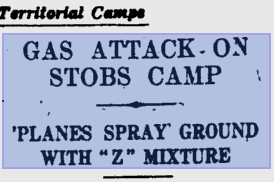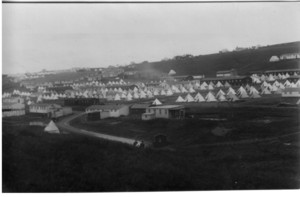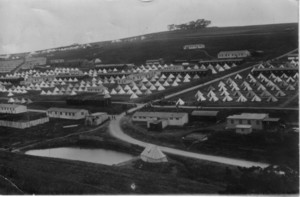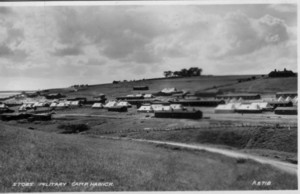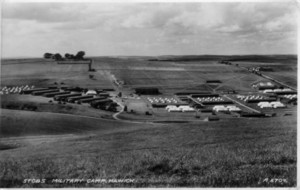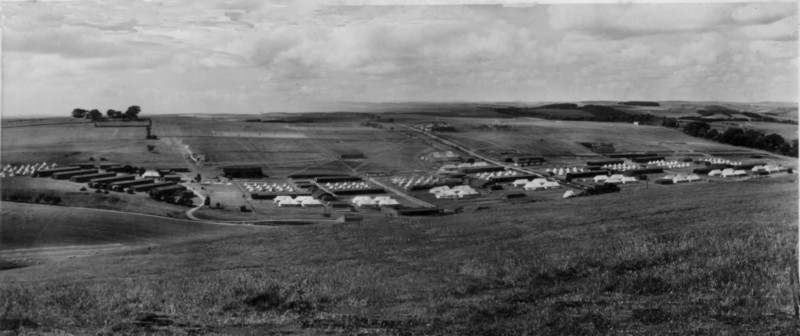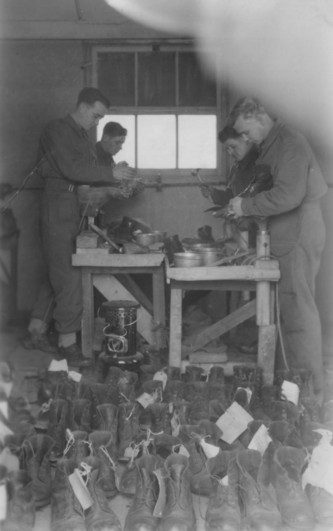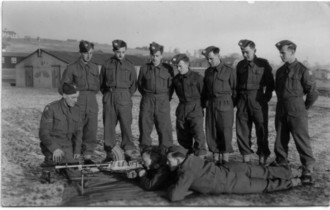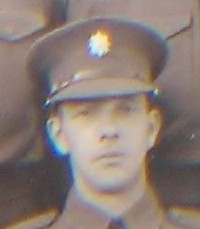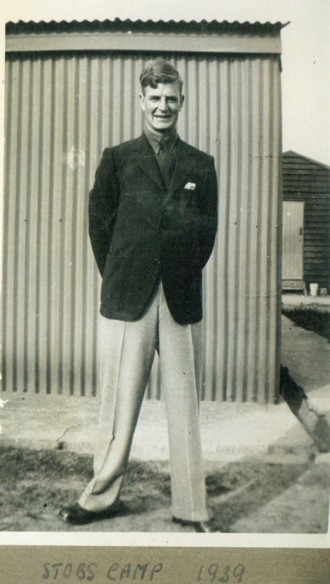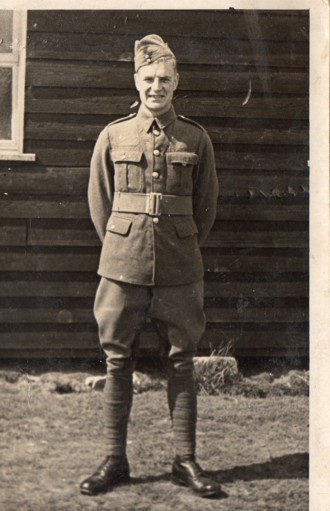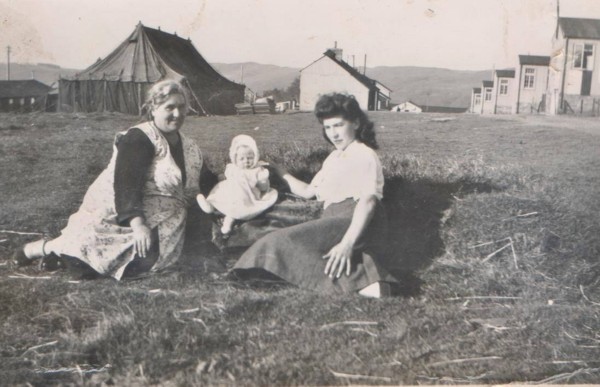|
WORLD WAR TWO |
||
|
Little information survives regarding the camp after the Great War. However, a specialist venereal disease hospital opened after the Armistice using the former German POW hospital. Eventually, there was a return to a summer training routine and for some reason, many of the old P.O.W huts were removed.
|
||
|
|
The Glasgow Herald of July 8th, 1939 featured a short article on gas training at Stobs:
"A gas attack was made yesterday on Stobs Camp Hawick, where the men of the Lanarkshire Yeomanry are in training. Two R.A.F planes from Edinburgh crossed and recrossed the camp for 20 minutes, spraying acres of ground with "Z mixture". "Z Mixture" is a substance which looks and smell exactly like mustard gas, but has none of the harmful effects. This is the first time the regiment has taken part in an exercise of this kind, but troops in protective clothing manned Bren guns on the hills and were able to keep up continuous "fire" throughout the raid. |
|
|
|
Two months later, with the beginning of the Second World war, Stobs became the focus of new activity and a new building programme was begun. Nissan huts were erected and electricity was generated at a new power station |
|
|
|
Secrecy surrounds activity at the camp during the war as little was written in local newspapers of life in the camp. Tank Regiments are known to have used the range above Shankend Viaduct and there are remembered instances of tanks "bogging-down" and sinking in some of the quagmires which surround the camp. |
|
|
Units of the Royal Marines trained at Stobs from 1941. An intelligence report details a lapse in security at the camp on 3rd September, 1941: "Sergeant Houston who was unchallenged by the main gate sentry enquired "Where am I?" Not only did he receive the name of the camp but also the further information that 3 and 5 Royal Marines were in residence, and Brigade HQ were in Stobs Castle. Lieutenant Anderson entered the camp on motorcycle at 2228, also unchallenged, and fired 2 pistol shots before riding out by another route. Two minutes later at 2230, L/Cpl Nixon walked up behind the Arms Dump and placed a time bomb by it whilst Sgt Polack kept the sentry talking: Nixon then fired three Verey Lights but the sentry took no action! One man took some photographs inside the camp without being challenged. It was obvious that there was very little security, and no security-mindedness in the Brigade" |
||
|
|
||
|
|
Ron Leadbetter wrote: "The 1st battalion Irish Guards came back from Anzio, Italy in 1945 and when I joined them, they were at Stobs. I believe the whole brigade were at Stobs. Due to heavy loses at Anzio, the battalion found it imposible to be reinforced and did not fight again. On VE NIGHT the town was solid with locals and Guardsmen." Bren Gun training, unit and date unknown |
UNITS KNOWN TO HAVE BEEN AT STOBS 1939-45
1st Battalion Irish Guards 2nd Battalion Royal Ulster Rifles (definately at Hawick) 2nd Battalion Scots Guards 2nd Battalion Lincolnshire Regt. 3rd Royal Marines 5th Royal Marines 1st Battalion Welsh Guards |
|
|
||
|
Guardsman Albert B. Summers, no. 2702537, was born in Fraserburgh in 1917, and on 4th May, 1944, he enlisted at Caterham into the 2nd Battalion Scots Guards. He was at Stobs from early November 1944 to late January 1945, where he received his 'finishing-off' training, and it was from there that he received his embarkation Orders for North West Europe. In letters written to his wife, he described some experiences of Stobs.
|
Albert Bruce Summers (1917-1993) |
|
|
|
|
|
|
||
|
The BBC 'People's War' website is a treasure trove of WWII veterans' stories |
||
|
George Daily - Black Watch, 1939-46 |
John Richards - Grenadier Guards |
Norman Irwin - Scots Guards |
The local people were very good to us lads. It was nothing, when out training in the hills, for a farmer’s wife to come out with jugs of milk and new baked scones to feed us up, much to the disgust of our sergeant. “This is nae a bluidy picnic” he would say. The farmer’s wife just ignored him. She probably had kin in the forces. After a few months at Stobs Camp we said cheerio to the rats and moved into a nice clean nissen hut at nearby Selkirk [February 1943]. We also had a new Platoon Officer, who had just been called up, he wasn’t very old, about the same age as the rest of us. His first job was to give me a stripe, which I refused, but he threatened to move me away from my mates to another platoon, so I became a lance corporal! Yes lance corporal Daily...unpaid and unwanted! To make matters worse I was put on a charge on the first day of my promotion because one of the lads had not made his bed properly. This came to light during a billet inspection. We soon got into the swing of our new environment, between training and visits into Selkirk. We went to all the local dances, although it was a bit dicey trying to do a slow foxtrot in army tackity boots. There were quite a few bruised toes amongst the Selkirk lassies, and a few broken hearts when we left. |
I was there training for 3 months and then went on to Victoria barracks, Windsor for another 3 months training. After that I was drafted to Stobs military camp in Scotland. It was like
the Arctic there - snow, ice and no running water because it was all frozen. I was there until September and we
had Irish guards there too. |
We were in Hawick in Scotland. They sent them up there for training. We were supposed to be the
bees’ knees. We were experts in desert warfare. We were experts in mountain warfare in Italy. We were amphibious
experts. |
|
|
||
|
|
||
|
|
Ian Marshall sent me the following: My dad's name was John Marshall he seemingly served in the Royal Artillery and also the Royal Army Service Corps He started his war service at Stobs camp it was written under his photo in civies and we assume this was him before he was given his uniform he had said that his first uniform dated from ww1 and another showed him in it. One other photo is of "B" Battery 14th searchlight militia at Stobs Camp 1939 (shown above) |
|
|
|
||
|
Only a small number of German Prisoners were held at the camp during the war and until the
very last days of the war, they were housed under canvas within a small stockade. Another camp, Wilton Camp at
Howdenbank in Hawick seems to have been the main camp for prisoners. |
|
|
|
|
||
|
|
Malcolm Mcdonald's Granny pictured at Stobs. Date unknown. |
|
 |
||
